- Table of Content
- 1.Exceptional de...
- 2.X-class flares...
- 3.PROBA2 Observa...
- 4.Review of spac...
- 5.Noticeable Sol...
- 6.International ...
- 7.Geomagnetic Ob...
- 8.The SIDC Space...
- 9.Review of Iono...
- 10.STCE seminars ...
2. X-class flares aplenty
3. PROBA2 Observations (30 Sep 2024 - 6 Oct 2024)
4. Review of space Weather
5. Noticeable Solar Events
6. International Sunspot Number by SILSO
7. Geomagnetic Observations in Belgium
8. The SIDC Space Weather Briefing
9. Review of Ionospheric Activity
10. STCE seminars and courses
Exceptional detection of an X9.0 flare by PROBA2/LYRA
On October 3, the Sun unleashed its most powerful eruption since 2017: a solar flare classified as X9.0 on the GOES scale, accompanied by a significant coronal mass ejection (CME). The flare originated in a solar region that had shown increasing activity for several hours (NOAA 13842). As a result, the event did not come as a surprise to the scientists working with PROBA2.
At the time of the flare, the PROBA2 team was conducting a special observation campaign. Both of the satellite’s instruments, SWAP and LYRA, successfully captured the event in detail. Notably, LYRA was operating with its backup unit—preserved for critical observations—which recorded the flare’s signature across at least three of its four channels, as shown in the figures below.
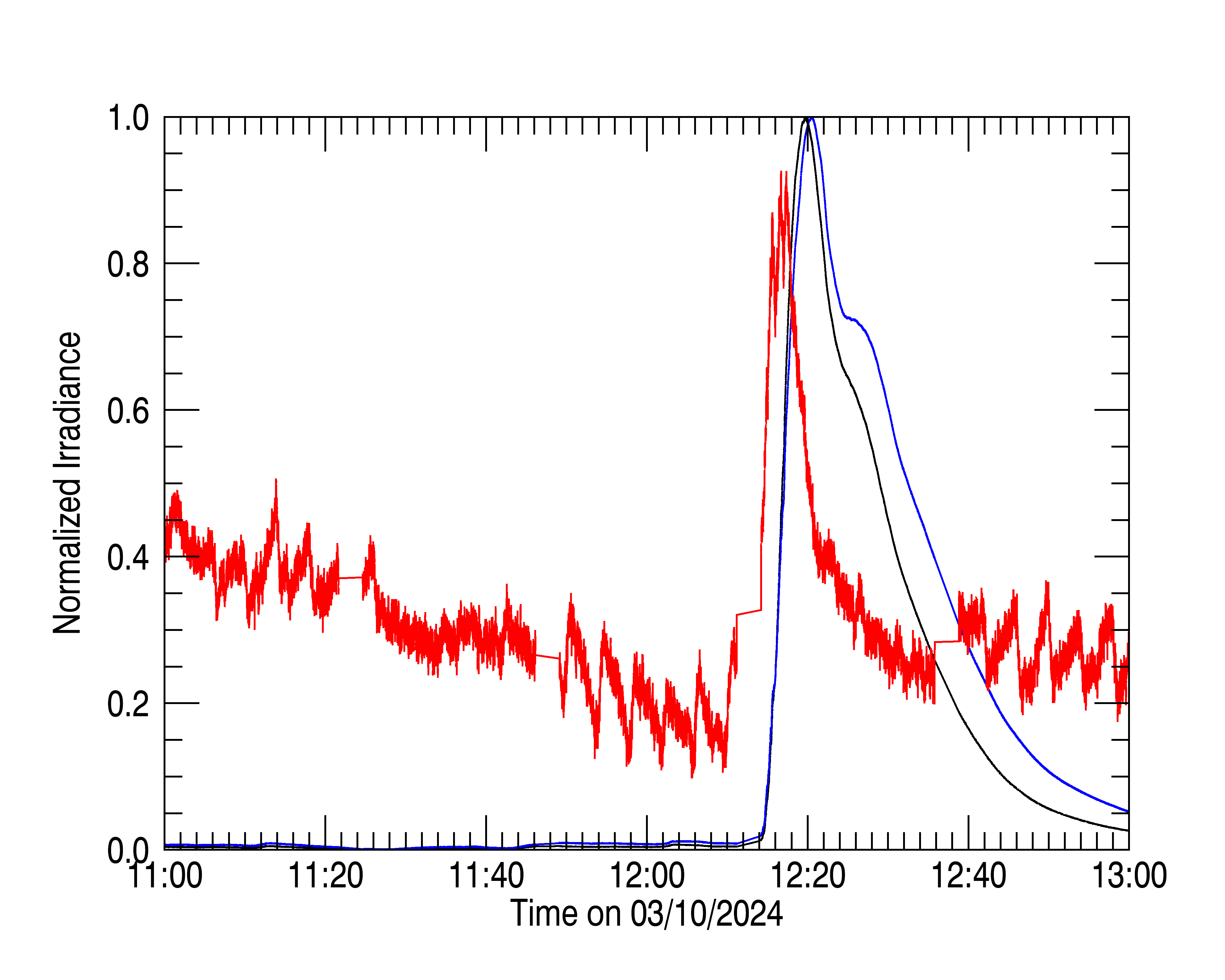

The flare signature observed in the four channels of LYRA: Lyman-alpha (red), Aluminum (blue), Zirconium (black), and Herzberg (green).
The detection of the flare in the Lyman-alpha channel (represented by the red curve) is especially significant, as only a few dozen similar detections have been made over the entire mission. Interestingly, the fourth channel (the Herzberg channel, shown in green) also registered an increase in signal. However, the data from this channel did not follow the typical pattern of a solar flare, prompting further investigation.
PROBA2 scientists will now analyze whether this signal was directly caused by the solar flare, another coinciding phenomenon, or more likely, a combination of both. If the flare is confirmed as the cause, this will mark only the second time a solar flare has been observed in the Herzberg channel—emphasizing the scientific importance of this event.
The SWAP observations of this remarkable flare can be seen in this movie made with JHelioviewer: https://proba2.sidc.be/Events/2024-Oct-03-X9flare/SWAP_X9flare.mp4
X-class flares aplenty
NOAA 3842 was the main source of enhanced solar activity over the last week. This sunspot region rotated over the southeast solar limb on 27 September, gradually growing in size and complexity. It developed an important magnetic delta structure in its leading sunspot as shown in the white light image and magnetogram underneath resp. left and right (SDO). As a result, it produced three X-class flares: An X7.1 event on 1 October, an X9.0 flare on 3 October, and an X2.1 flare on 7 October. Details and imagery can be found in the online STCE newsflash at https://www.stce.be/news/727/welcome.html As seen from Earth (GOES), the X9.0 flare is the strongest flare of solar cycle 25 (SC25) so far.

Coronal mass ejections (CMEs) were associated with these flares, as shown in the compilation underneath with SDO/AIA 094 images in the top row, and SOHO/LASCO C3 coronagraphic images in the bottom row. However, the CME of the X7 flare was rather weak and barely discernable in the coronagraphic imagery. Also, the X2 flare apparently destabilized the magnetic structures in the neighbouring regions, resulting -amongst other- in the eruption of a nearby 35-degrees long filament early on 08 October. The X2 flare may also have triggered an X1 flare over NOAA 3844 which started minutes after the X2 event and peaked about 2 hours later. So this seems to be then the fourth X-class flare in just one week, but the jury is still out on this one! Only one clear CME was observed associated with these X2-X1 flares, as can be seen in the lower right coronagraphic image, with the bright dot being Mercury (located on the opposite side of the Sun), and the bright feature to the right comet Tsuchinshan–ATLAS that will soon become visible in the evening sky of the Earth's northern hemisphere. This CME has an earth-directed component, and the SIDC forecaster expects a glancing blow on 10 October around noon.

So, together with other eruptive activity from NOAA 3842 during the 1-4 October timeframe, a string of earth-directed CMEs was on its way and started to influence the earth environment from 6 October onwards. Initially, the geomagnetic field was not disturbed very much. However, as one interplanetary CME after the other knocked on the geomagnetic field's door, and the Bz (vertical component of the interplanetary magnetic field) became more negative (up to -16 nT), the ensuing geomagnetic storms also grew in intensity. Eventually, early on 8 October, strong (major) storming levels were reached with NOAA's estimated Kp reaching 7+ and the Potsdam Kp 7o. Interestingly, the local K index for Belgium (K_BEL) reached only minor storming levels. The provisional Dst index reached its most negative value (-153 nT) during the 07-08 UTC interval.

PROBA2 Observations (30 Sep 2024 - 6 Oct 2024)
Solar Activity
Solar flare activity fluctuated from moderate to high during the week.
In order to view the activity of this week in more detail, we suggest to go to the following website from which all the daily (normal and difference) movies can be accessed: https://proba2.oma.be/ssa
This page also lists the recorded flaring events.
A weekly overview movie can be found here (SWAP week 758).
https://proba2.sidc.be/swap/data/mpg/movies/weekly_movies/weekly_movie_2024_09_30.mp4
Details about some of this week’s events can be found further below.
If any of the linked movies are unavailable they can be found in the P2SC movie repository here
https://proba2.sidc.be/swap/data/mpg/movies/
Wednesday Oct 2

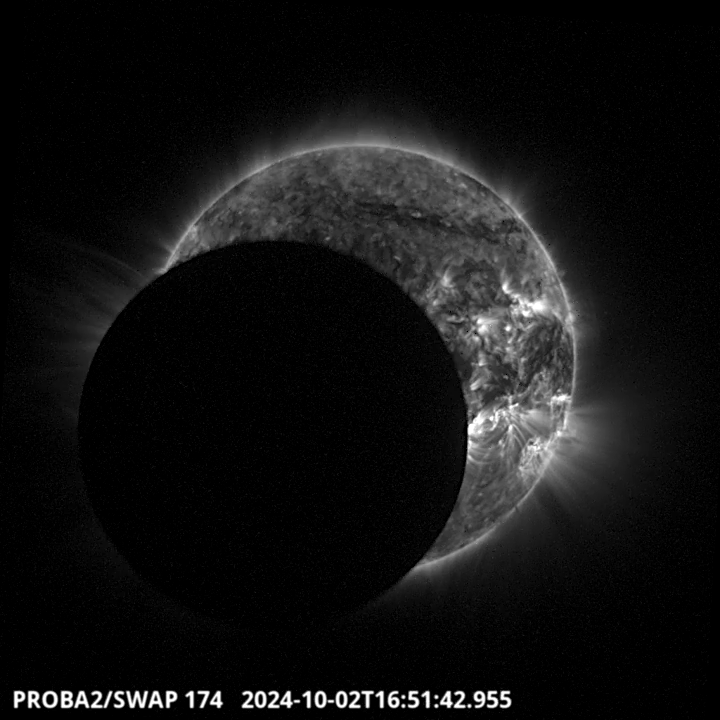
The solar eclipse of October 2 was observed and recorded by LYRA and SWAP. The irradiance
plots above, corresponding to the two primary transits of PROBA2 through the eclipse zone,
illustrate the gradual reduction in irradiance across the four channels of LYRA's backup unit as
the Moon passed in front of the Sun. The SWAP image captures the moment when the eclipse
reached its maximum phase. More detailed explanations can be found on the proba2 website https://proba2.sidc.be/October2_SolarEclipse. Find a SWAP movie of the event here. https://proba2.sidc.be/swap/movies/20241002_swap_movie.mp4
Thursday Oct 3
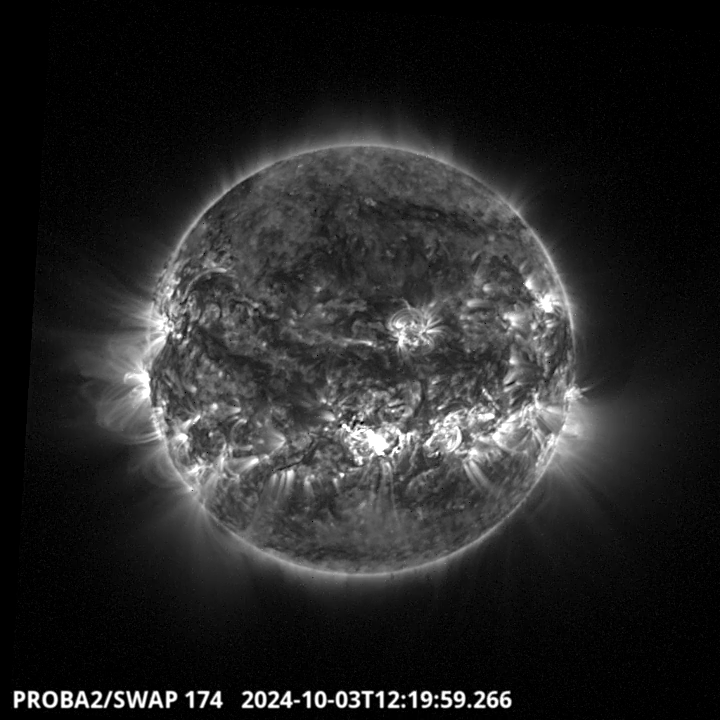
The strongest solar flare of the current solar cycle, which reached the X9.0 class, was produced
by the active region 3842 around 12:18 UT. It produced an Earth-directed CME. Additionally,
around 13:30 UT, a filament erupted in the North-West part of the solar disk (see also the SWAP
difference movie https://proba2.sidc.be/swap/movies/20241003_swap_diff.mp4). Find a SWAP movie of the event here. https://proba2.sidc.be/swap/movies/20241003_swap_movie.mp4
Review of space Weather
Solar Active Regions (ARs) and flares
The solar flaring activity was moderate to very high with several M-class flares and two X-class flares. There were 15 numbered active regions on the visible solar disk throughout the week which produced more than 30 M-class flares and 2 X-class flares. The largest flare was an X9.0 flare (SIDC Flare 2210) peaking at 12:18 UTC on Oct 03, which was produced by SIDC Sunspot Group 257 (NOAA Active Regions 3842). During the flare, the source region (SIDC 257) of the flare had beta-gamma-delta configuration of its photospheric magnetic field. SIDC 257 (NOAA AR 3842, beta-gamma-delta magnetic configuration) produced the two X-class flares and most of the M-class flares. Other two magnetically complex regions (beta-gamma-delta magnetic configuration) present over the past week were SIDC 273 (NOAA AR 3844) and SIDC 217 (NOAA AR 3848).
Coronal mass ejections
During the past week, six notable coronal mass ejections (CMEs) were observed, one of which was a halo CME.
The first CME was observed on SOHO/LASCO coronograph images starting around 23:12 UTC on Oct 01, on SE limb. This CME was possibly associated with an X7.1 flare from SIDC Sunspot Group 257 (NOAA Active Region 3842, S16 E16), which peaked at 22:20 UTC on Oct 01, and th EUV wave. Associated type II radio emissions were also detected at 22:17 UTC on Oct 01. This CME had a projected speed of about 600 km/s and a projected width of about 119 degree, but it was not detected at Earth.
A second CME was first observed at 08:34 UTC on Oct 03 which was associated to a filament eruption and the flaring activities from the SIDC 217 (NOAA AR 3848), on the NE quadrant of the Sun. It had a projected width of about 100 deg and a projected speed of about 525 km/s. With the bulk of the mass strongly directed towards NE limb, only a glancing blow was expected but it was not detected at Earth.
A third (halo) CME was observed in SOHO/LASCO-C2 images at 12:48 UTC on Oct 03, which was associated with the largest X9.0 flare (peak: 12:18 UTC) produced by the SIDC 257 (S15 W03). The associated EUV wave was also observed. Associated type IV and type II radio emissions were detected at 12:17 UTC and 12:18 UTC, respectively, during the flaring activity. The CME had a projected speed of about 850 km/s.
Another subsequent fourth CME was observed at 13:27 UTC on Oct 03 which was possibly associated to an eruption near the SIDC 217. It had a projected width of about 100 degree and a projected speed of about 500 km/s. With the bulk of the mass strongly directed towards the NE, only a glancing blow was expected but it was not detected at Earth. Though there is a possibility that it arrived at Earth together with the above halo CME.
A fifth CME was observed at 20:36 UTC on Oct 03 at the West limb which was associted with a M6.7 flare (peak: 20:28 UTC) produced by the SIDC 272 (NOAA AR 3843, S07 W45). Associated type II radio emissions were detected at 20:12 UTC, during this flaring activity. The associated EUV wave was also observed. It had a projected width of about 119 degree and a projected speed of about 850 km/s.
A sixth (faint) CME was observed at 04:13 UTC on Oct 04 which was possibly associated to two eruptions on the SW quadrant of the Sun. The first eruption was below the SIDC 273 (NOAA AR 3844) starting from 03:00 UTC on Oct 04, and the second eruption was associated with a M4.0 flare (peak: 04:55 UTC) produced by the SIDC 257 (S16 W17). The southward dimming associated with the flare was also observed. It had a projected speed of about 550 km/s and a projected width of about 114 degree (as detected by CACTUS tool).
Coronal Holes
A small equatorial positive polarity coronal hole (CH) has crossed the central meridian on Oct 05.
Proton flux levels
The greater than 10 MeV GOES proton flux was below the 10 pfu threshold level over the past week.
Electron fluxes at GEO
During the last week, the greater than 2 MeV electron flux, as measured by the GOES-16 satellite, was below the 1000 pfu threshold level. The 24h electron fluence was at normal level during the past week.
Solar wind
At the beginning of the week, Earth was under the influence of high speed streams which originated from the negative polarity coronal hole that crossed the central meridian Sep 26. The solar wind speed remained below 550 km/s with the interplanetary magnetic field (IMF) reaching 15 nT and North-South component (Bz) down to -12 nT. Slow solar wind regime existed from Oct 02 to Oct 05. At the end of the week on Oct 06, solar wind parameters were enhanced due to the arrival of an interplanetary coronal mass ejection (ICME) associated with CMEs observed on Oct 03. A shock was detected in the solar wind data around 06:47 UTC on Oct 06. The IMF increased from 8 nT to 13 nT, the solar wind speed increased from 415 km/s to 465 km/s, and the solar wind density at the shock increased from 1.4/cm3 to 2.4/cm3. Following the arrival of ICME, the solar wind speed was as high as 550 km/s with the IMF reaching 17 nT and Bz down to -12 nT.
Geomagnetism
Geomagnetic conditions were shortly at active conditions (NOAA Kp and K_BEL 4) at the beginning of the week, globally from 00:00 UTC to 03:00 UTC on Sep 30 and locally over Belgium from 13:00 UTC to 16:00 UTC on Sep 29, following the arrival of a high speed stream originated from coronal hole that crossed the central meridian on Sep 26. After that, it was both globally and locally at quiet to unsettled conditions (NOAA Kp and K_BEL 1 to 3). At the end of the week, geomagnetic conditions reached minor storm conditions ((NOAA Kp=5) globally and active conditions (K_BEL=4) locally over Belgium following the arrival of an interplanetary coronal mass ejections (ICME) associated with CMEs that were observed lifting from the Sun on Oct 03.
Noticeable Solar Events
| DAY | BEGIN | MAX | END | LOC | XRAY | OP | 10CM | TYPE | Cat | NOAA |
| 30 | 2337 | 2359 | 0023 | S18E30 | M7.6 | 2N | 31 | 3842 | ||
| 01 | 1441 | 1452 | 1456 | S12W9 | M1.0 | 1N | III/1 | 30 | 3843 | |
| 01 | 1852 | 1917 | 1937 | S17E9 | M1.5 | SF | 31 | 3842 | ||
| 01 | 2158 | 2220 | 2229 | S16E17 | X7.1 | 2B | II/3 | 31 | 3842 | |
| 02 | 0231 | 0239 | 0243 | N12E8 | M1.2 | SF | 25 | 3841 | ||
| 02 | 0530 | 0538 | 0546 | S15E20 | M3.6 | SF | III/3CTM/1II/2 | 31 | 3842 | |
| 02 | 0619 | 0624 | 0628 | N11E78 | M1.1 | SF | 3848 | |||
| 02 | 1322 | 1338 | 1358 | S19E7 | M3.2 | 1N | 31 | 3842 | ||
| 02 | 2027 | 2051 | 2106 | S15E3 | M3.3 | 2 | III/1 | 31 | 3842 | |
| 03 | 0223 | 0234 | 0248 | N13W8 | M1.1 | SF | 25 | 3841 | ||
| 03 | 0322 | 0341 | 0359 | M1.5 | VI/2 | 31 | 3842 | |||
| 02 | 1958 | 2015 | 2027 | M1.4 | III/1 | 31 | 3842 | |||
| 03 | 0810 | 0828 | 0830 | N12W8 | M1.5 | SF | 25 | 3841 | ||
| 03 | 0830 | 0836 | 0841 | M1.5 | 31 | 3842 | ||||
| 03 | 1208 | 1218 | 1227 | X9.0 | CTM/1III/1IV/1II/2 | 31 | 3842 | |||
| 03 | 1718 | 1721 | 1727 | S16W26 | M1.5 | SF | 34 | 3844 | ||
| 03 | 2009 | 2028 | 2040 | S9W47 | M6.7 | 2 | II/2 | 30 | 3843 | |
| 03 | 2139 | 2141 | 2148 | S15W26 | M2.3 | SN | 34 | 3844 | ||
| 04 | 0009 | 0017 | 0025 | N14W21 | M1.2 | SF | VI/2 | 25 | 3841 | |
| 04 | 0436 | 0455 | 0507 | S16W17 | M4.0 | 1N | VI/2 | 31 | 3842 | |
| 03 | 2325 | 2328 | 2330 | S10E0 | M1.1 | SN | II/2III/3 | 31 | 3842 | |
| 04 | 1058 | 1103 | 1116 | M1.2 | III/1 | 3836 | ||||
| 04 | 2055 | 2104 | 2113 | S15W42 | M1.1 | SF | 34 | 3844 | ||
| 04 | 2204 | 2211 | 2218 | N17W83 | M1.2 | 1N | 32 | 3845 | ||
| 05 | 0007 | 0012 | 0019 | S13W22 | M1.0 | SF | 31 | 3842 | ||
| 05 | 0837 | 0844 | 0850 | M1.6 | VI/1 | 31 | 3842 | |||
| 05 | 0818 | 0827 | 0837 | M1.4 | VI/1 | 31 | 3842 | |||
| 05 | 2033 | 2040 | 2046 | M1.1 | III/2 | 31 | 3842 | |||
| 05 | 2310 | 2320 | 2328 | S13W35 | M2.4 | SF | 31 | 3842 | ||
| 06 | 0009 | 0018 | 0029 | M1.0 | 31 | 3842 | ||||
| 06 | 1514 | 1521 | 1525 | S15W65 | M1.3 | SN | 34 | 3844 | ||
| 06 | 1641 | 1645 | 1651 | M1.0 | 31 | 3842 | ||||
| 06 | 1852 | 1859 | 1904 | S17W48 | M1.4 | SF | 31 | 3842 | ||
| 06 | 2052 | 2119 | 2147 | S14W57 | M1.5 | SF | VI/2 | 31 | 3842 |
| LOC: approximate heliographic location | TYPE: radio burst type |
| XRAY: X-ray flare class | Cat: Catania sunspot group number |
| OP: optical flare class | NOAA: NOAA active region number |
| 10CM: peak 10 cm radio flux |
International Sunspot Number by SILSO
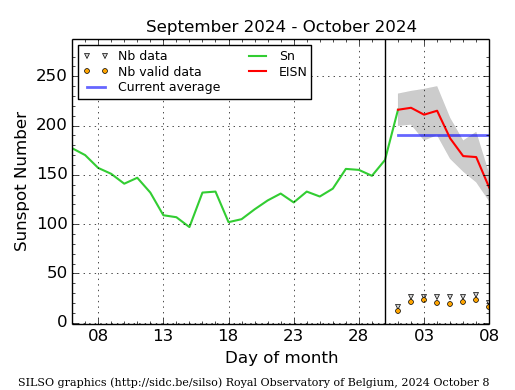
The daily Estimated International Sunspot Number (EISN, red curve with shaded error) derived by a simplified method from real-time data from the worldwide SILSO network. It extends the official Sunspot Number from the full processing of the preceding month (green line), a few days more than one solar rotation. The horizontal blue line shows the current monthly average. The yellow dots give the number of stations that provided valid data. Valid data are used to calculate the EISN. The triangle gives the number of stations providing data. When a triangle and a yellow dot coincide, it means that all the data is used to calculate the EISN of that day.
Geomagnetic Observations in Belgium

Local K-type magnetic activity index for Belgium based on data from Dourbes (DOU) and Manhay (MAB). Comparing the data from both measurement stations allows to reliably remove outliers from the magnetic data. At the same time the operational service availability is improved: whenever data from one observatory is not available, the single-station index obtained from the other can be used as a fallback system.
Both the two-station index and the single station indices are available here: http://ionosphere.meteo.be/geomagnetism/K_BEL/
The SIDC Space Weather Briefing
The Space Weather Briefing presented by the forecaster on duty from Sept 30 to Oct 6.
The pdf of the presentation can be found here: https://www.stce.be/briefings/20241007_SWbriefing.pdf

Review of Ionospheric Activity

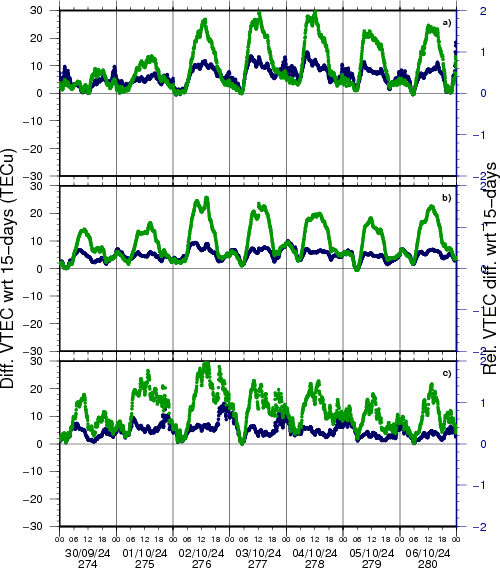
VTEC time series at 3 locations in Europe from 30 Sep 2024 till 6 Oct 2024
The top figure shows the time evolution of the Vertical Total Electron Content (VTEC) (in red) during the last week at three locations:
a) in the northern part of Europe(N 61deg E 5deg)
b) above Brussels(N 50.5deg, E 4.5 deg)
c) in the southern part of Europe(N 36 deg, E 5deg)
This top figure also shows (in grey) the normal ionospheric behaviour expected based on the median VTEC from the 15 previous days.
The time series below shows the VTEC difference (in green) and relative difference (in blue) with respect to the median of the last 15 days in the North, Mid (above Brussels) and South of Europe. It thus illustrates the VTEC deviation from normal quiet behaviour.
The VTEC is expressed in TECu (with TECu=10^16 electrons per square meter) and is directly related to the signal propagation delay due to the ionosphere (in figure: delay on GPS L1 frequency).
The Sun's radiation ionizes the Earth's upper atmosphere, the ionosphere, located from about 60km to 1000km above the Earth's surface.The ionization process in the ionosphere produces ions and free electrons. These electrons perturb the propagation of the GNSS (Global Navigation Satellite System) signals by inducing a so-called ionospheric delay.
See http://stce.be/newsletter/GNSS_final.pdf for some more explanations; for more information, see https://gnss.be/SpaceWeather
STCE seminars and courses
Courses, seminars and presentations with the Sun-Space-Earth system and Space Weather as the main theme. We provide occasions to get submerged in our world through educational, informative and instructive activities.
* Oct 17, STCE seminar Investigating the effect of solar flares on the ionosphere with a network of state-of-the-art ionosondes, Brussels, Belgium
* Oct 21 - 22, Second e-SWAN school - data, models and observations relevant to Space Weather and the Ionosphere, by the STCE - Registrations are open, https://events.spacepole.be/event/209/
* Nov 25 - 27, STCE course: Space Weather impacts on ionospheric wave propagation, focus on GNSS and HF, Brussels, Belgium - Registrations are open, https://events.spacepole.be/event/206/
* Dec 5-6, STCE Course Space Weather impacts on aviation, Brussels, Belgium - Registrations are open, https://events.spacepole.be/event/205/
To register for a course and check the seminar details, surf to the STCE Space Weather Education Center: https://www.stce.be/SWEC
If you want your event in the STCE newsletter, contact us: stce_coordination at stce.be
